- Retour accueil
- Vous êtes ici : Blog Chemistry in Ancient Egypt The disc of Sabu is a schist dome shaped and perforated plate that was installed inside counterflow chemical reaction towers for natron manufacturing ©2021
The disc of Sabu is a schist dome shaped and perforated plate that was installed inside counterflow chemical reaction towers for natron manufacturing ©2021
Publié par Bruno Coursol dans Chemistry in Ancient Egypt le 26/06/2021 à 07:53

The disc of Sabu is a dome shaped and perforated plate that was installed inside a counterflow chemical reactions unit that would become on Sneferu's reign a Solvay-like tower for the manufacturing of Sodium Carbonate Na2CO3, the purest mineral form of natron, the salt used by ancient Egyptians for the mummification process. In the center : schematic drawing of a 1800s European carbonation Solvay tower, showing the segmentation layout in individual chamber units and the counterflow dome shaped discs.
A metasiltstone schist artifact from the first Dynasty
The disc of Sabu was discovered in the tomb of prince Sabu (around 3100-3000 BC), pharaoh Anedjib’s son, by Walter Bryan Emery, a British Egyptologist who devoted his career to the excavation of archaeological sites along the Nile Valley. Anedjib was the fifth pharaoh of the first dynasty of Ancient Egypt.
The disc is made of metamorphic siltstone, a very fragile material that is actually a schist stone, and had been entirely carved from a single block. The disc of Sabu has a maximum diameter of 61 cm (24.01 inches) and a maximum height of 10.6 cm (4.17 inches) ; in the middle it has a hole of about 8 cm in diameter (3.15 inches).
From Wikipedia : "Possible uses: mixing tool for mixing grains, with meat and water, and perhaps fruits and other. Other uses attempted - no further use, when inventor died. Tool used during large gatherings. Not a very successful design, buried with inventor. Sentimental value."
Other explanations include : "incense holder", "lotus flower shape vase" or "piece of a steam machine or turbine"...
Many theories have been written about the Disc of Sabu, but the disc was not a part of any machinery involving rotating pieces of equipment or any steam machine : the disc of Sabu is way too fragile.
The disc of Sabu and the ammonia-soda Solvay process
The purpose of this blog, and this article in particular is to demonstrate that the disc of Sabu had a key role in what was the first technological research program of our species, and that everything we call today ancient Egyptian religion is actually referring to their technological accomplishment in physics and chemistry.
The disc of Sabu was set inside counterflow reaction chambers, that were most probably piled up into towers, for the chemical manufacturing of sodium carbonate (also called natron, the salt used by ancient Egyptians for the mummification process) and sodium bicarbonate. Ancient Egyptians were the first to develop the ammonia-soda process, also called Solvay process.
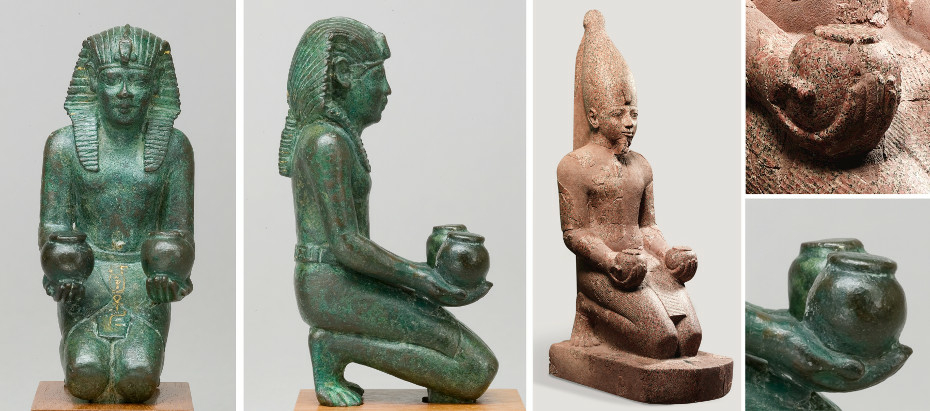
Pharaohs Amasis and Hatshepsut are not shown in a purification or baptism act : they are not bringing libation vessels so that their content would be used right away ; they are demonstrating that the chemical manufacturing of sodium carbonate and sodium bicarbonate was successful. On the artifact farther below, king Taharqa is doing the same thing, but in front of the representations of the chemical manufacturing process heat (the falcon) and its cooling (the snake).
If it was for purification, there wouldn't need to be 2 vessels, and the lids would have been removed.
It is said in literature that this exact kind of ancient Egyptian libation vessels are made for water purification, or sometimes for beer or wine. But if you really are planning for a religious purification act, you don't come with the lids on the libation vessels : you remove the lids. If the lids are still on the vessels, it is because whatever is inside them, it needed to be sealed off.
Left images : Kneeling statuette of King Amasis from the Metropolitan Museum of Art, New-York. Accession Number: 35.9.3 ; 570–526 B.C. Center image : Large Kneeling Statue of Hatshepsut. Accession Number : 30.3.1 also from the MET (ca. 1479–1458 B.C).
Low-Tech capabilities with infinite human and financial resources
As I have already suggested in previous posts, I believe that what we call today "ancient Egyptian gods" were actually metaphoric representations of Natron manufacturing by a Solvay-like process, that started most probably before Dynasty 1. This "quest" was nothing else than an applied research programme on the field of chemical manufacturing and it is even possible that this programme resulted in the very first Dynasty, the "Dynasty 0" or " Dynasty 00".
The first thing to understand is that ancient Egyptian scientific and technological knowledge was nothing like modern Egyptologists love to describe.
I'm not saying they were using electricity or any other thing that fancy, but they were at the very top of what we call today "Low Technology". The Low Tech is based on very natural and simple concepts, but if you have "infinite human and financial resources" like pharaohs did, you can achieve extraordinary results.
The Great Pyramid of Khufu is the outcome of that research programme, but what we know of that pyramid today is only its lower part. That "Lower Great Pyramid" was designed to produce, store and transfer cold to the Upper Great Pyramid, where were installed the counterflow reaction Solvay chambers.
The cold was produced by one of the most important Low Technology : the adiabatic evaporative cooling. If you put very small droplets of liquid water into dry air, the water evaporates by taking energy from the air. As a result, the air loses energy and cool down.
The very first pyramid, the step pyramid of Djoser was called "the refreshment of the Gods"
If the idea of a technological role of the Great Pyramid, as a cold production unit, might seem to be troubling, let's keep in mind the official name of the very first pyramid, the step pyramid of Djoser (around 2650 BCE), that was called the pyramid of " the refreshment of the Gods".
It just turns out that this name has to be taken literally.

Chemistry was the real secret of ancient Egyptian pharaohs and Djed Pillars were very real structures involved in that field.
The 2 final magical products of the Solvay process : sodium carbonate and sodium bicarbonate
It is only since I started to work on the Red Pyramid of Sneferu that I could figure out the reason why ancient Egyptians had to produce cold in the Great Pyramid : they were trying to master the natron manufacturing by the Solvay process, or a Solvay-like process. Since then, I only focused myself on the sodium carbonate manufacturing, because it is the purest mineral form of natron, and so I thought it was the goal of the entire process ; but it was probably a mistake : the Solvay process final products are actually 2 different components : the sodium carbonate (natron Na2CO3) and the sodium bicarbonate (NaHCO3, also called today baking soda or bicarbonate of soda).
Both have plenty of purposes, but the more important is that they were made by pure chemistry. That chemistry craft was most probably seen by the people as pure magic.
If I'm correct, the 2 libation vessels shown in so many figures and reliefs, are actually representing these 2 components.
The 2 patinated vessels : the successful chemical manufacturing demonstration
I may be wrong, because I don't know the history of this particular Amasis figurine shown above, but it also looks like the 2 vessels appear patinated, like they were touched hundreds or thousands of times, like worshipping people still do today on some parts of statues all over the world.
For more details about the Natron manufacturing and the Solvay process, please visit the post on the Red Pyramid.
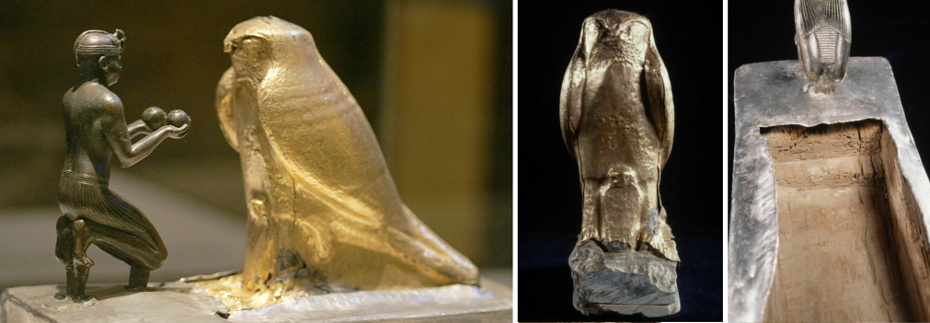
Pharaoh king Taharqa presenting god Hemen with wine E25276, from the Louvre Museum, Paris.
This amazing artifact from the Louvre Museum is outstanding, because it shows a pharaoh kneeled down in front of the representations of the heat generated by the chemical manufacturing (the falcon) and the cold production (the snake), both put on the representation of the impactor of the grand gallery / inclined well : the wooden hollow base of the figure.
King Taharqa is thanking the gods for the successful chemical manufacturing
There is no offering in this scene : the pharaoh isn't giving anything to anybody and he is even not physically connected to the rest of the artifact because he is not part of the action.
That is the falcon and the snake who gave the content of the bowls to him.
The falcon is a metaphor of the natron manufacturing heat and the snake represents the cold made out of water that cooled down the reactions.
King Taharqa, like Amasis and Hatshepsut, is simply thanking the gods with the highest respect for giving him the 2 bowls content, and that is certainly not wine as indicated in the data sheet of the artifact, but very much probably sodium carbonate and sodium bicarbonate if I am right about the Solvay process.
The fact that the snake is gently put between the falcon's legs, is also a perfect metaphor of the balance achieved between the heat of the Upper Great Pyramid chemical reactions and the cold produced by the Lower Great Pyramid.
The falcon and the snake should engage into a mortal combat, but they are not, they have been perfectly domesticated ; the heat and the cold have been perfectly mastered.
The snake predators feeding metaphors of the cold production
We've seen in previous posts that the key element of the cold production process in the Great Pyramid, was water and that it was represented by a snake. The great amount of pressurized water inside the inclined well was represented by the Great Serpent Apep (Apophis) and the small amount of water injected inside the evaporative cooling passage was represented in the Dendera reliefs by a small snake.
So the snake is a representation of the cold, and that cold was transferred to the Solvay towers. It is like the Solvay towers were fed with the cold. That explains why so many animals that are eating snakes as a regular diet, appear so often in ancient Egyptian religion scenes.
The mongoose, the hawk and vulture, the crocodile, the cat, the ibis... all of them are snake predators : they are nothing else than cold feeding metaphors for the Solvay reaction chambers.
The chemical manufacturing as a legitimacy to reign demonstration
These statues of pharaohs holding the 2 vessels, would also reinforce the idea that part of pharaohs legitimacy to reign was coming from their ability to demonstrate their mastering of the "magical" chemical manufacturing to their people.

Schist discs like the disc of Sabu (First Dynasty) were used inside Solvay-like towers as dome shaped and perforated plates for counterflow chemical reactions, probably until way after the end of the Fourth Dynasty.
The counterflow chemical principle is the key of the disc of Sabu original function
The Solvay process used in the Sodium Carbonate manufacturing, is based on the counter current principle : the brine, saturated with ammonia NH3 gas, slowly passes through the carbonating tower, from top to bottom, while carbon dioxide CO2 is injected at the bottom of the tower and forced to top. Brine and CO2 are both passing through the perforations of the mushroom shaped plates, counterflow.
One disc for 2 possibilities of counterflow chemical reactions
Other the years, probably dozen or hundreds of discs, identical or similar to the tri-lobed schist disc of Sabu, would have been crafted. There could have been 2 major uses for such discs :
1/ The ammonia saturation of the brine
The 50% salt concentration brine had first to be saturated with NH3, ammonia gas. The brine was poured on the top dome shaped side of the disc and the NH3 was injected at the bottom of the unit or the tower so that the liquid and the ascending gas would react through this counterflow design.
Typically, this is the saturation tower of the Solvay process.
2/ The carbonation of the ammoniated brine (more likely), as shown in the diagram below
Once the brine is saturated, the same process takes place, but this time this is the ammonia saturated brine that is gonna be reacting with an ascending flow of high temperature CO2 coming from the limestone kiln.
Typically, this is the carbonation tower of the Solvay process.

If the Red Pyramid has a nearly identical layout than a European Sodium Carbonate production plant in the early 1800s, the Bent Pyramid, just next to the Red one, already starts to show imprints of counterflow chemical reaction towers like the ones used nowadays in the ammonia-soda plants functioning on the Solvay process.
The Sodium Carbonate manufacturing by the Solvay process in Europe (1861 to nowadays)
That Solvay process was invented in Belgium in 1861. In Europe, the industrial chemistry started with the glass industry, and the ones who mastered the glass manufacturing process, in the first place, were the Egyptians, 5000 years ago. That is 500 years before Sneferu's reign and the Great Pyramid.

Left and right : the Meidum Pyramid, built by pharaoh Sneferu. Center : the Red Pyramid at Dashur, by the same king. What is remarkable in the Meidum pyramid is that it shows a perfect split of the Red Pyramid layout in 2 completely independent parts. The red layout is the energy circuit, from the limestone kiln to the exit of the pyramid. The green layout shows the 2 chemical reacting chambers and the start of the descending passage, where the natron would be separated from the steam getting out of the Red Pyramid.
The Meidum pyramid was nothing else than the mock-up of the Red Pyramid's internal layout.
Sneferu's pyramids were built to achieve the manufacturing of the purest mineral form of natron.
It seems that the Meidum Pyramid was a test mockup of the Red Pyramid, where each part could have been tested separately before putting everything together and build a fully functional Red Pyramid.
Actually, the global layout of the Red Pyramid is surprisingly nearly identical to a European sodium carbonate plant in the early 1800s and based on the late 1700s work by the French chemist Nicolas Leblanc. Sodium carbonate is the modern term for natron, the mummification salt used by ancient Egyptians.
For more details about the copy-paste similarities between the Red Pyramid and the 1800s typical sodium carbonate plants in Europe, please visit : http://www.verre-histoire.org/colloques/innovations/pages/p302_01_chopinet.html
In this article, drawings from Figuier are very interesting, because they show the similar layout of the Red pyramid and the 1800s European plants for natron production : 3 adjoining and successive chambers, connected by low ceiling corridors and ended by an exhaust conduct. But the author also points out that in Europe, the industrial chemistry started with the glass industry.
And the ones who mastered the glass manufacturing process, in the first place, were the Egyptians, 5000 years ago. That is 500 years before Sneferu's reign and the Great Pyramid.
They couldn't cool down the towers
Because of the huge ammonia smell in the Red Pyramid, we know they didn't control the chemical reaction temperatures : the ammonia is indispensable for the Solvay process to work, but the chemical balances of the ammonia cycle, if the temperatures are controlled enough, give to this element a minor role : there is about the same amount of ammonia consumed than ammonia produced by the Solvay process. If huge quantities of ammonia were produced, it is because they couldn't cool down the towers.
The visible part of the Great Pyramid of Khufu was designed to fix this particular problem, with the horizontal evaporative cooling passage. The cold (between 5°C and 10°C, or 41°F to 50°F), was stored inside the Queen's chamber and then transferred to a Red Pyramid-like natron manufacturing unit, that is still standing today inside the pyramid, waiting to be discovered.
The Great Sneferu's fourth culmination pyramid at Giza
The quest of the purest natron manufacturing by Khufu's father, explains why Sneferu built 3 complete pyramids. There was no mistake or last minute change of mind, but a very modern technological development program. The Red Pyramid shows they were having difficulties in controlling the temperature of the chemical reaction units and that was the purpose of the Great Pyramid : cold production.
The Great Pyramid was the outcome of Sneferu's research program, in some way it is his fourth pyramid, and the reason this pyramid is so big, is because they had to implement a cold production unit to the initial Red Pyramid layout.
To understand the disc of Sabu, you first need to figure out the Red Pyramid of pharaoh Sneferu
The Red Pyramid is the one telling us that the all thing was about sodium carbonate chemical manufacturing. The ammonia smell of this pyramid and the layout of its chambers tell us that it was operated exactly the same way as for the 1800s European Sodium Carbonate plants did, with 3 adjoining and successive chambers, separated by 2 low ceiling corridors and ended by an exhaust conduct.
The Meidum pyramid wasn't a functional pyramid, but was used as a scale model, a mockup of the Red Pyramid, and served to make fine adjustments of the 2 big layouts of its operating process.
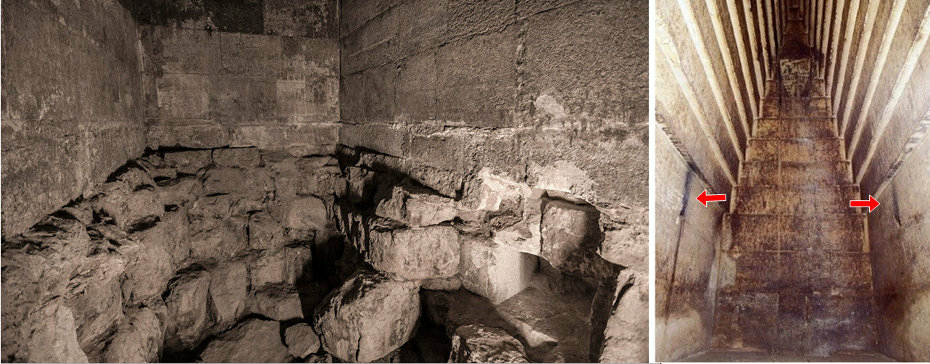
The Red Pyramid of pharaoh Sneferu, with the burial chamber and the hole supposedly digged by robbers (left photograph). On the right photograph, the adjoining chamber where dark traces are coming out of opposite holes. These traces had been recently cleaned, as well as all the other traces of the wall, now hidden with modern stairs.
The dark traces indicate that (hot) gases were injected trough these holes into structures that were put into the chamber.
The ammonia smell of the Burial chamber
On the first photograph of the burial chamber, the blocks have also been recently covered with cement, I assume to reduce the ammonia smell. These stones would have been indirectly highly heated by the furnace of the limestone kiln, they would have get very dry, and when the operating of the Red pyramid was over, I guess all the ammonia got released in the pyramid and these dry rocks would have "suck in" huge amount of it.
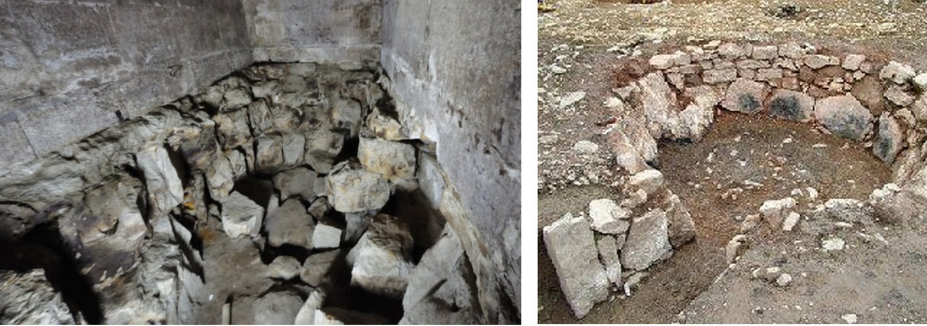
On the left : the "burial chamber" of the Red Pyramid at Dashur, before cement has been poured on the blocks, I presume, in order to reduce the ammonia gas emissions. Image on the right : ancient limestone kiln at Betws yn Rhos, Abergele (Wales, United-Kingdom).
The burial chamber of the Red Pyramid was a limestone kiln : the first step in sodium carbonate manufacturing (natron)
That burial chamber was actually a limestone kiln and it explains why there is no floor, why the remaining blocks are burnt and laid out in concentric circles, why they are forming a cone shaped hole and why there is a little passage, supposedly digged by robbers. Please note, on that photograph, the burnt block on the foreground left corner. If you look attentively, you can find such burnt blocks all over the pit.
1/ The limestone kiln layout (red) for lime and CO2 production
The red layout indicates the "energy circuit", from the limestone kiln that was operated inside what is called today "the burial chamber", to the descending passage and the exit of the pyramid. Lime and CO2 were used inside the 2 chemical reaction chambers, through a Solvay-like process.
2/ The 2 chemical reaction chambers layout (green)
The green layout shows the 2 chemical reacting chambers and the start of the descending passage, where the natron was separated from the steam getting out of the pyramid.
The Red Pyramid is in some way, the most important of all pyramids, because it tells us what was the real goal of the 3 pyramids of Sneferu and the real function of the Great Pyramid of Khufu, his son.
For details about the natron manufacturing in the Red Pyramid, please visit this page of the blog:
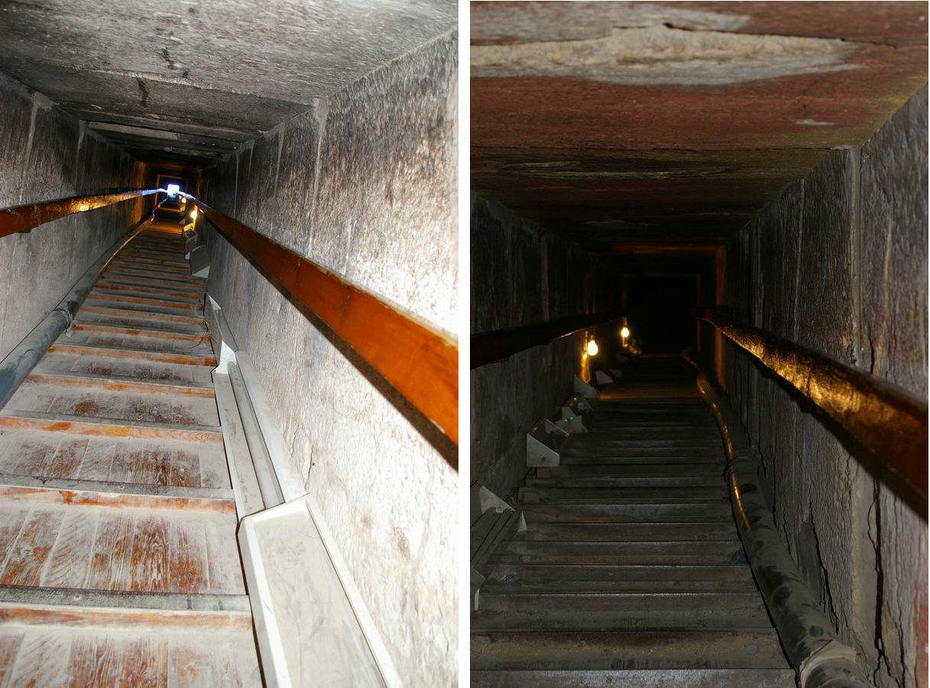
On the left is the lower part of the Red Pyramid descending passage (looking up) and showing only the natural color of the stone blocks. On the right is the same passage (looking down), above the lower section, and showing red and yellow deposits. Where the ceiling has been recently damaged, we can see the natural color of the stone. Red and yellows really are deposits, they are not the natural color of the blocks : some activity inside the pyramid, after the passage was built, was responsible for their presence.
The red deposits on the Red Pyramid descending passage and the ferrite iron of the disc
The schist material contains a mineral with a very high concentration of iron : the ferrite. It is possible that the red deposits that are still visible inside the descending passage of the Red Pyramid (mostly on the ceiling), are coming from this ferrite mineral. The heat coming from the limestone kiln CO2 would have extract ferrite iron from discs of Sabu and it would have then deposit itself in the passage, where it would have rust and turn red.
It is still unclear to me where the yellow deposits we can also find in the passage are coming from.
Water, heat and cold insensibility : the metamorphic schist resistance properties
The disc of Sabu is made of a very particular stone that gives to it properties perfectly fit for the job : the metamorphic schist. The disc would have been placed inside counterflow chemical reaction towers (the Djed Pillars) or units (the Abu Gorab stone basins) and submitted to very harsh conditions : the disc would have been in contact with very concentrated brine (50% salt solution or more) and saturated with ammonia NH3 and with very hot CO2 gas. Also, as we can see on the Abu Gorab 3 holes cracked stone basins, the different units, stacked or lined up, would have been cool down and subject to high levels of thermal stress.
Schist is completely waterproof and insensible to cold or hot temperatures.
Metamorphic schist isn't sensible to fire or frost damaging. These properties explain why, in many regions of the world, this material is used to cover house's roofs : slates are made of metamorphic schist.
The metamorphic schist weakness : its fragility
The brittleness of the schist explains why it is mostly only used nowadays on roofs : it isn't supposed to get hit by anything. The same way, the disc of Sabu was perfectly secured inside the towers or the individual units they were in : the only stress the discs of Sabu would have been subject to, was thermal and chemical.
That thermal stress problem was what caused the discs to break, and that is the origin of the Eye of Horus broken into pieces myth (see more below).
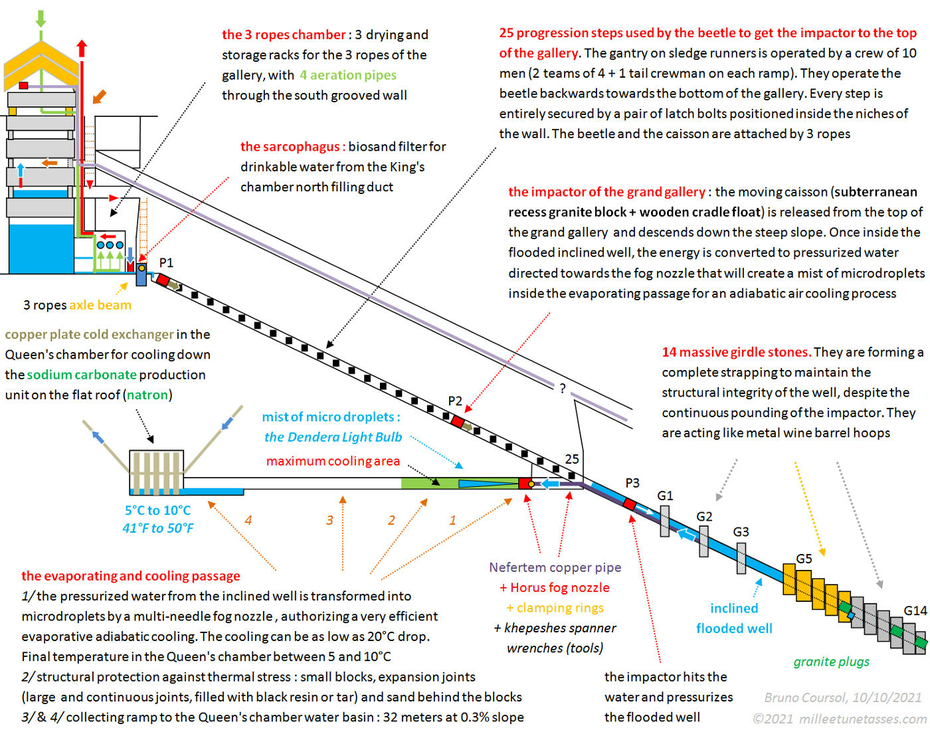
The known part of the Great Pyramid of Khufu at Giza (what I call the Lower Pyramid), was designed to produce cold inside the Queen's chamber. The temperature could have been as low as 5°C or 10°C (41°F or 50°F), by an evaporative cooling process inside taking place in the horizontal passage. The cold was used to cool down counterflow chemical reactions, most probably very similar to the modern ammonia Solvay process used for Sodium Carbonate manufacturing (the purest mineral form of natron, the salt used for the mummification). The Solvay unit would have been set on a "flat roof" at the level of the Lady Arbuthnot's chamber (that is the Upper Pyramid).
The constant high humidity rate resulting of the evaporative cooling created in the horizontal passage and the Queen's chamber is explaining the presence of very thick and hard incrustation of salt in both of these parts of the Great Pyramid (read more on that subject in Section 1, paragraph 1.03).
Most of ancient Egyptian gods and artifacts didn't exist at the time of Sneferu's reign
The first thing we should have in mind in regards to ancient Egyptian studies, is that pretty much everything we can think of nowadays with religious significance, didn't exist at the time when Sneferu was building his pyramids and planning for the Great Pyramid at Giza, that I believe will inherit his son, Khufu.
At the time of Sneferu and the Fourth Dynasty, the scarab amulets didn't exist ; gods Horus, Isis, Osiris, Nefertem, Ptah, Sokar, etc. didn't exist. The Eye of Horus didn't exist. The Four Sons of Horus didn't exist. The scarab beetle faced god Kephri-Ra didn't exist. The 8 Ogdoad primordial deities didn't exist. All these elements only start to appear progressively with the Fifth and Sixth Dynasty.
The question everyone should ask, is what the heck happened, that would explain that suddenly, in just a period of a few decades, scarab beetle amulets were crafted by vast numbers and all these new "gods" appear with so many unusual artifacts (the Khepeshes, the wooden base of figurines in the shape of a wooden beam, lotus flowers with copper pipes, etc.).
Pretty much everything we know about ancient Egyptian religion starts with the pyramid texts on the Fifth Dynasty: "The Pyramid Texts are the oldest ancient Egyptian funerary texts, dating to the late Old Kingdom. They are the earliest known corpus of ancient Egyptian religious texts. Written in Old Egyptian, the pyramid texts were carved onto the subterranean walls and sarcophagi of pyramids at Saqqara from the end of the Fifth Dynasty, and throughout the Sixth Dynasty of the Old Kingdom, and into the Eighth Dynasty of the First Intermediate Period" (source : Wikipedia).
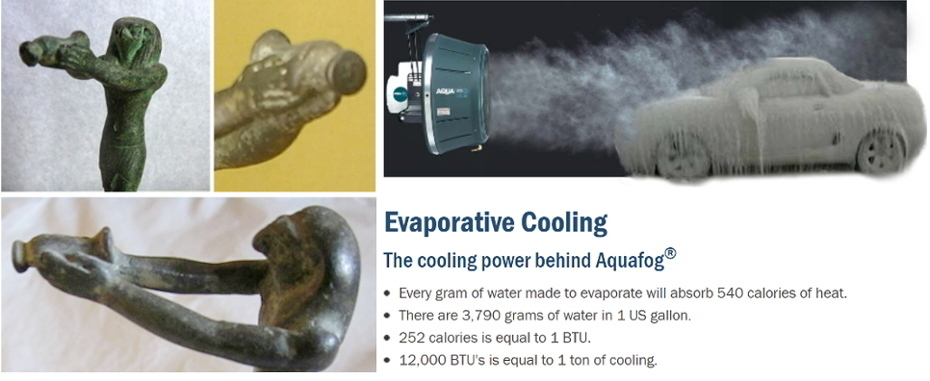
The ancient Egyptian god Horus, holding the fog nozzle of the evaporative cooling passage of the Great Pyramid.
Horus images : E3752 from the Louvre Museum and figurine of Horus DUT162 also from the Louvre Museum ; Paris, France, Hauteur : 9 cm ; Largeur : 2,7 cm ; Profondeur : 6 cm. Date de création/fabrication : Basse Epoque (664 - 332 BCE).
Evaporative cooling applications webpage screenshot : AquaFog® from Jaybird Manufacturing Inc (Pennsylvania, USA).
The entire Lower Pyramid was designed to produce, store and transfer cold to the Solvay reaction chambers on the Upper Pyramid : the Lower Great Pyramid was entirely dedicated to cool down the chemical reactions that Horus is representing.
The surprising efficiency of the evaporative cooling process that created cold in the horizontal passage of the Great Pyramid of Khufu, is still used today in modern evaporative coolers
"Evaporative coolers lower the temperature of air using the principle of evaporative cooling, unlike typical air conditioning systems which use vapor-compression refrigeration or absorption refrigeration. Evaporative cooling is the conversion of liquid water into vapor using the thermal energy in the air, resulting in a lower air temperature". Source : Wikipedia
The European Emergence of the Technology analogy (1500 to 1750)
The Great Pyramid is only the outcome of many decades of technological research on chemical manufacturing that started probably around the very first Dynasty, like it is suggested by the disc of Sabu, dated from first Dynasty.
In Europe, it took about 250 years to achieve the Emergence of the technology (1500 to 1750), with the Renaissance and Leonardo da Vinci; and another 150 years for the Industrial Revolution (1750 to 1900).
Ancient Egyptians were most probably slowed down in their research by the lack of power, because contrary to what the western world had in the 1700's or 1800's in Europe, they didn't have the steam engine.
My guess is that, in some ways, ancient Egyptians got stuck in the first step of technological evolution : they were a civilization living the Emergence of the technology.

The horizontal cooling passage of the Great Pyramid at Giza was connected to Solvay (or Solvay-like) towers for the manufacturing of natron. These towers needed to be cooled down, at least to 10°C (50°F). Elevation data (inches) : "The pyramids and temples of Gizeh", by Petrie, W. M. Flinders (William Matthew Flinders), Sir, 1853-1942 ; section 40 (page 66) : "Passage to Queen's Chamber", third column mentioned "floor level"
The Great Pyramid of Khufu was a profound Change of Civilization Event
When operating, the Great Pyramid would have appeared like a living beast : a lot of noises, fumes and smoke would get out of it. 4,500 years ago, no wonder such a sight changed forever the identity of the Egyptian people and was at the origin of many symbolic or mythological scenes, figures, gods and artifacts.
One of the ramifications of my theory about Sneferu's pyramids, is that many aspects of ancient Egyptian religion and artifacts, maybe even most of them, are based on the operating of the Great Pyramid at Giza. Everything starts with Sneferu's reign and is quest for the sodium carbonate manufacturing: Sneferu wanted pure "magical" man made natron for his mummification, and probably other purposes, like chemical "magical" demonstrations to the people.

The disc of Sabu was fully protected inside staked casing units that were forming Solvay towers.
On the left drawing, the liquid is poured inside the tower from a point near the top (P), while the gas is injected at the bottom of the tower (C). This is a Solvay tower, so the liquid is an ammonia saturated salt brine solution, and the gas is CO2 coming from a limestone kiln. The result is the carbonation of the ammoniated brine and the reaction takes place onto the dome shaped and perforated plates. The disc of Sabu is one of this plates. Each segment of the tower is cooled down by water pipes (B).
If most of the counterflow towers had been destroyed, there is one place in Egypt where some of these elements can still be found, and they are the stone basins of the Sun Temple of Nyuserre at Abu Gorab, near Memphis.
This Sun Temple had been built for King Nyuserre Ini, the sixth ruler of the Fifth Dynasty during the Old Kingdom period.
The steam machine theory of Gizo Vashakidze, Institute of Applied Ecology, Tbilisi State University, Georgia.
This theory actually got very close to decipher the disc of Sabu. The author understood very well that the disc was designed to deal with hot gases and liquids. Unfortunately, he thought of a steam machine, because he made a model that shows very interesting properties regarding of steam dispersal from a pan of hot water.
Extract from his work : "The appearance of the disc of Sabu has generated quire a different idea in me. According to its shape I have supposed that this thing was created by ancient Egyptians for the contact of air and water. To substantiate this idea I have made the dummy of this disc. I erected the vertical axis where the disc dummy was put and made the disc to move vertically with the help of ropes, up and down. Then I poured hot water in the vessel below."
If you want to have a look at his work, please click here
The upside down position of the disc of Sabu inside the counterflow reaction chambers
In some way, the steam machine of Gizo Vashakidze is emphasizing the fact that the disc of Sabu was indeed designed to deal with ascending steam or other kind of hot gases.
But we can also find other experiments showing that the disc was also designed to deal with liquid, poured on its dome shaped face. For that, you need to watch the following video, here. The experiment consist of placing the disc in a water flow on both sides and see what happens to the rotating speed of the disc (actually, a 3-D printed copy of the disc, of course).
The result is simple and obvious : it is rotating, but you would have put anything, it would have rotate the same way. You would have put a perfect ball or a book, it would have rotate. The interesting thing about this experiment is that when you put the disc with the 3 lobes on top it is rotating 60 rpm, and when you put the disc with the dome face on top, it is rotating 94 rpm. That is a 56% increase. And that increase tells us that the disc was indeed, designed to receive poured liquid on its dome shaped face.
The disc of Sabu was put upside down inside the counterflow chemical reaction chambers (or towers).

The disc of Sabu was most certainly present inside some, or all of the Abu Gorab stone basins. The 2 lateral holes of the 3 hole basins were probably used to cool down the unit by water pipe.
The segmentation of the Solvay towers in identical units and the stone basins of the Abu Gorab "Solar Temple"
The stone basins on the left, with a single hole, look like they were filled with liquid and the ones on the right, with 3 holes, where probably cooled down by a pipe passing through the 2 lateral holes. Most of these basins show horizontal fractures passing through these 2 lateral holes, most probably resulting of the thermal stress induced by the cooling process. Please note that the central hole is nearly every time free of any fracture, like the one we see here.
It is still unclear to me though, if the segments were stacked vertically to form a tower or if they were aligned horizontally around the "altar".
I didn't find any mention of the dimensions of the square parts of the stone basins, neither the dimensions of the central part of the altar. It looks like there could have been a tower in this location, but without accurate dimensions, there can't be any strong belief of this.
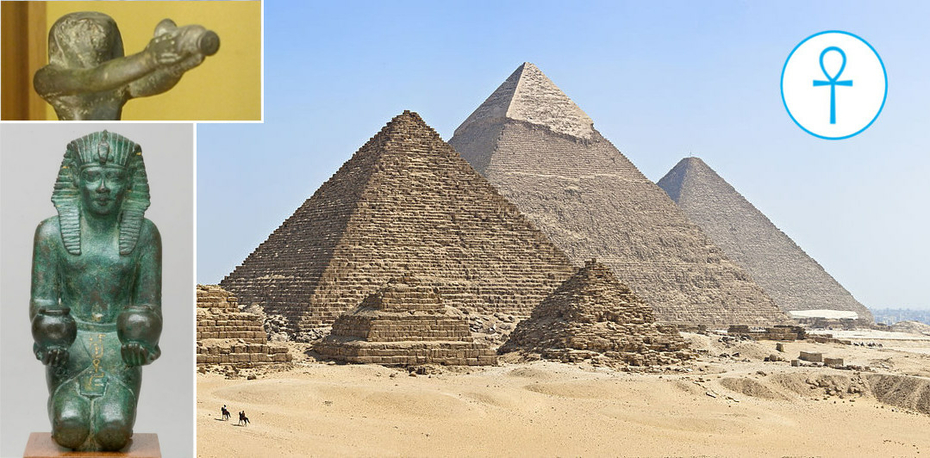
0.01 The Pyramids of the Cold - Very quick abstract of the study
Hidden behind the academic vision of the ancient Egyptian religion, a vast number of metaphors are describing some of the most advanced science and technological knowledge of that time.
Not only ancient Egyptian gods were pharaohs' metaphoric self-glorifications of their scientific accomplishments in physics and chemistry, but they also used this magical power to legitimate themselves as kings of Egypt.
Pharaohs forged an entire religion, based on science to become kings of Egypt. Magic was science.
The end game of this technological program was the Great Pyramid of Giza where evaporative cooling was engineered in the known part of the pyramid, using the power of water, most probably as suggested by the strong ammonia smell in the Red Pyramid, to cool down chemical manufacturing of sodium carbonate and sodium bicarbonate. At that time, sodium carbonate was called natron, and it was the salt used for the mummification of the pharaohs.
It means that ancient Egyptians were the first civilization to master a Solvay-like process for sodium carbonate manufacturing, long before it got reinvented in the 1800's in Europe. The key elements of that process is the temperature control of the chemical reactions (the cooling), and the dome shaped plate necessary for the counterflow chemical reactions to occur in an efficient way, and that plate is precisely what is the disc of Sabu.
Also, the very first pyramid complex, the Step Pyramid of Djoser, was called "the refreshment of the Gods".
0.02 The Pyramids of the Cold - Table of contents
Section 1 • The Evaporative Cooling Passage, Nefertem and the khepeshes
Section 2 • The Evaporative Cooling : the Dendera Light
Section 3 • The Evaporative Cooling : the Heka, Geb, Shu, Nut and Tefnut glorifying metaphors
Section 4 • The Inclined Well layout : the Girdle Stones and the interlocked blocks
Section 5 • The Inclined Well waters : the Apep metaphor of the pressurized waters
Section 6 • The Inclined Well : the Taweret Lady of the Well block
Section 7 • The Inclined Well : the Bes wedging block and the Māori ceremonial Haka
Section 8 • The Inclined Well : the draining of the well
Section 9 • The Inclined Well : the Was Scepter, the Sa Symbol and the Isis Knot
Section 10 • The Impactor
Section 11 • The Grand Gallery : the Hidden Hauling Cavern of the Underworld
Section 12 • The Grand Gallery : the Hauling Beetle designed for 8+2 crewmembers
Section 13 • The Grand Gallery : the Scarab Amulets
Section 14 • Solvay process (natron manufacturing) : the Red Pyramid
Section 15 • Solvay process (natron manufacturing) : the Disc of Sabu
Section 16 • Solvay process : the cooling of the Eye of Horus
Section 17 • The Ankh symbol and the changes made by Akhenaten & Nefertiti
Section 18 • The Sarcophagus of the Great Pyramid
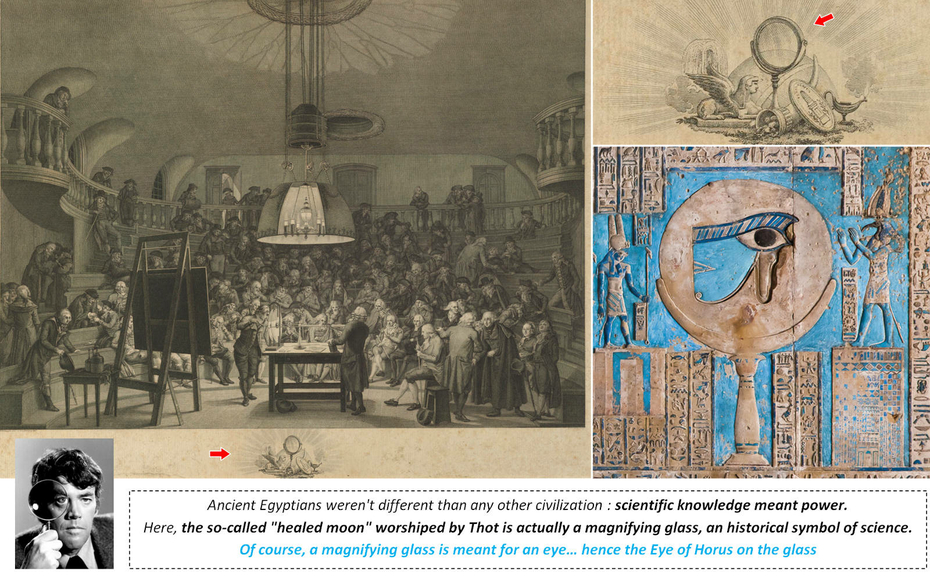
This engraving shows Dutch mathematician and physicist Jean Henri van Swinden (1746–1823) demonstrating the generation of electricity to the Felix Meritis Society in Amsterdam. The Felix Meritis Society was founded in the late 18th century to promote the arts and sciences (Felix Meritis translates as "Happiness through Merit"). Barbiers, Pieter Pietersz., and Jacques Kuyper. Courtesy of Science History Institute in Philadelphia : https://digital.sciencehistory.org/works/zg64tm573
The astronomical ceiling at the Pronaos : detail of the first Band west from the centre, showing the full "healed" moon on a pillar depicted as 'Wadjet' the Eye of Horus healed by Thoth, who is portrayed at the right. Thanks to Kairoinfo4U : https://www.flickr.com/photos/manna4u/9295311496
Jim Hutton as detective Ellery Queen, posing with a magnifying glass courtesy of NBC Television.
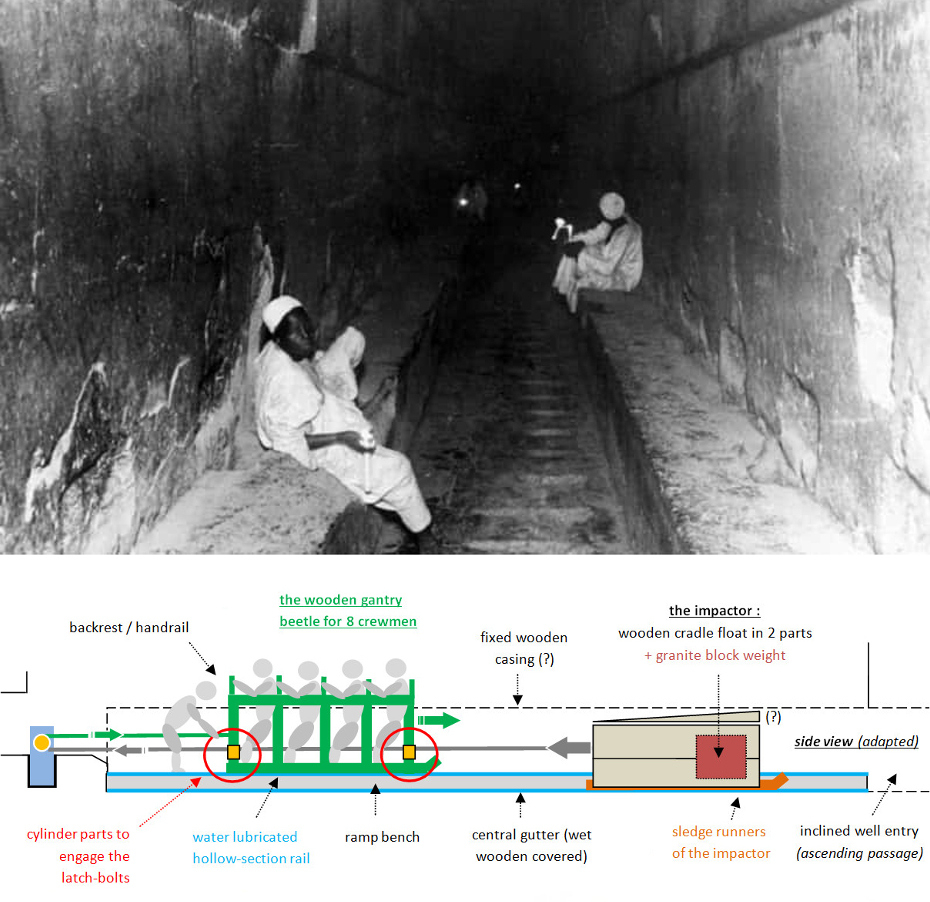
The Pyramids of the Cold - Section 12 • The Grand Gallery : the Hauling Beetle designed for 8+2 crewmembers

The Pyramids of the Cold - Section 7 • The Inclined Well : the Bes wedging block and the Māori ceremonial Haka
Simon Gray
WOW. I'm sorry, my French is terrible so I hope you can understand my English. This is amazing work - I always knew the pyramids had some kind of manufacturing purpose - your theory certainly has me convinced. It is said that originally the Great Pyramid was encased in great limestone facing stones which would have been fitted so tight you couldn't fit a razor blade between them. So this also fits with your theory, that the pyramid structure itself would have been built as airtight as possible to ensure temperatures inside were kept to their optimum and no leakages occurred.
The main reason I found your site was that I'm intrigued by the disc itself (or themselves - I believe there are many) and how it was actually produced. For me, there are too many clues and artifacts around to deny any technological application - especially given the discs were carved from a single block - could that REALLY have been achieved using hammer and copper chisels?!
Thank you for posting your work and long may it continue.
S. Gray
Jesús Mirabal
Tengo el conocimiento de como y para que se usaba este artefacto.
Envía correo y hablamos.
meritaten
This is all extremely interesting information you've presented. I still can't help but wonder why it would have been necessary for the Egyptians to build power-plants in alignment with the 4 cardinal directions, or why the structures themselves also seem to somehow be tracking celestial events such as the solstice/equinox?
I am also curious as to why it would be necessary to produce such large amounts of natron if it was primarily used for mummification? Perhaps it was also used during the manufacturing of 'concrete' (geopolymer)?
Bruno
Hello Rebekka,
You are pointing out what the real thing is all about : scientific demonstration.
This post about the Disc of Sabu is one of the first I've written last year, and at that time I've only started to scratch the surface of the big picture. I recommend you visit the new start page, 'the pyramids of the cold, table of content', so you get the latest updates.
https://www.milleetunetasses.com/blog/the-pyramids-of-the-cold/table-of-contents.html
The most important thing to understand about my study, is not that the Red Pyramid was built over a sodium carbonate (natron) and sodium bicarbonate manufacturing unit, or that the Great Pyramid of Giza was an evaporative cooling unit, most probably designed to cool down the same chemical manufacturing than the one in the Red Pyramid, but the fact that the entire ancient Egyptian religion was 'only' glorifying representations of these scientific accomplishments.
Ancient Egyptian pharaohs used science to legitimate themselves as Kings of Egypt. This is the key point.
Most probably, they built their religion to make people think that because of their successful mastering of 'the forces of Nature', they were Gods themselves.
Legitimacy to reign was coming from scientific knowledge, and the Pyramids were like demonstrations of that knowledge, whether it is referring to WHAT was done inside these Pyramids, or the WAY they were built : orientation, dimensions, etc.
It is very important to keep in mind that pretty much right after the Great Pyramid was built during the Fourth Dynasty, the construction of massive pyramids stopped abruptly. Instead, many deities start to appear with the Fifth Dynasty.
If I'm right about the sarcophagi of the Serapeum of Saqqara, being airtight tanks for sodium carbonate and sodium bicarbonate long term storing, protecting the products from the humidity of the air, pharaohs could have used these chemical in annual demonstrations.
If ancient Egyptian religion is all about physics, chemistry and other scientific knowledge, then it means that the annual festivals are also about scientific demonstrations.
Sean
Amazing work, I have been fixated on this all day. As a nuclear engineer and expert in thermodynamic processes this is beyond breaking my brain.
Llouis
Great ! I do not know if you are right but it is as much - or more - credible that the official version of the "communité scientifique".
Marko
Great theory, but why they would construct such a big and complex plant if natron is in abundance in Wadi El Natrun, where Egyptians exploited it.
Bruno
That’s a good question, and I’ll suggest you to read “The Pyramids of the Cold v2” on this blog. There is a huge difference between getting natron found on the ground and chemically manufacture 100% pure sodium carbonate ‘natron’: the goal is to produce it and to demonstrate scientific and technological knowledge. Ancient Egyptians did have trouble with the cold production, it probably was their end game quest, just like today we still want to get as close as possible to the lowest temperature possibly attainable. The official name of the very first pyramid, the Step Pyramid of Djoser was indeed called “the Pyramid of the refreshment of the Gods”. Read “the Pyramids of the Cold”.
Poster un commentaire
